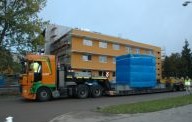A fusion reactor dismantled in the UK and reassembled in the Czech Republic celebrated its first plasma late last year.
The Compass D reactor formerly belonged to the UKAEA at its Culham research centre, but when a new facility called MAST (Mega Amp Spherical Tokamak) started up in 1999, Compass became surplus to requirements. Meanwhile, the Czech Academy of Sciences' (CAV) small Russian-designed tokamak, Castor – built in the 1950s and installed in Prague in 1977 – was becoming outdated. The solution? The UKAEA gave Compass to the CAV.
.2.jpg) |
|
.jpg) |
|
| From top left: Compass is lifted through the roof of UKAEA Culham; transported on a flatbed across Europe; and safely installed at IPP Prague. (Images: UKAEA Fusion; IPP Prague; Vesmir/S Vanek) |
|
On 9 December 2008, subsystem tests were completed, the tokamak was fuelled and a plasma discharge took place. The CAV reported that the results of technical tests showed Compass had operated very successfully. Furthermore, this had been achieved before the end of 2008, according to schedule.
Compass was removed from its Culham home and transported to Prague, where it was officially unveiled on 1 April last year. The 21 tonne unit was rebuilt in a specially constructed building in Prague by the CAV in cooperation with the CKD group, with refurbishments including new power supplies, diagnostics and a new control and data acquisition system.
As the only tokamak in the eastern European Union countries, the CAV's Institute of Plasma Physics (IPP) says the Compass reactor will enable the Czech Republic to expand its fusion research and conduct a series of plasma physics studies of direct relevance to the Iter project.
According to reports, the CAV paid the UKAEA a symbolic £1 for the tokamak, which otherwise would be worth some half a billion Czech Koruna (around $32 million).






_18570.jpg)
_16159.jpg)
_49205.jpg)





